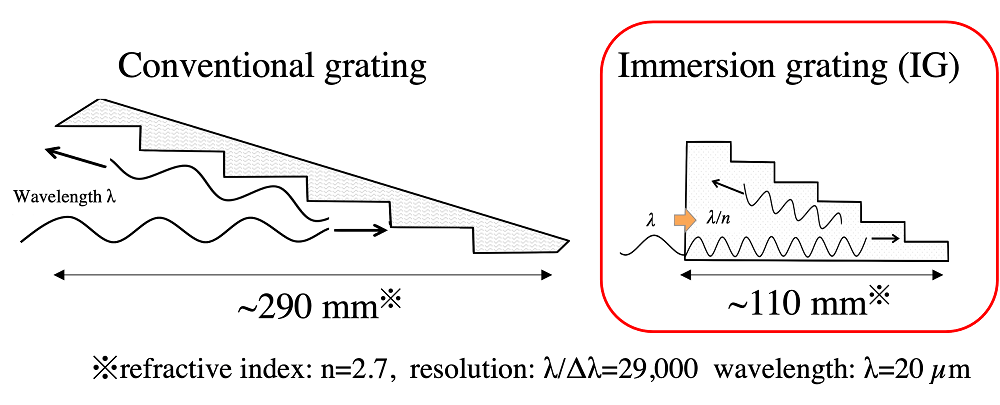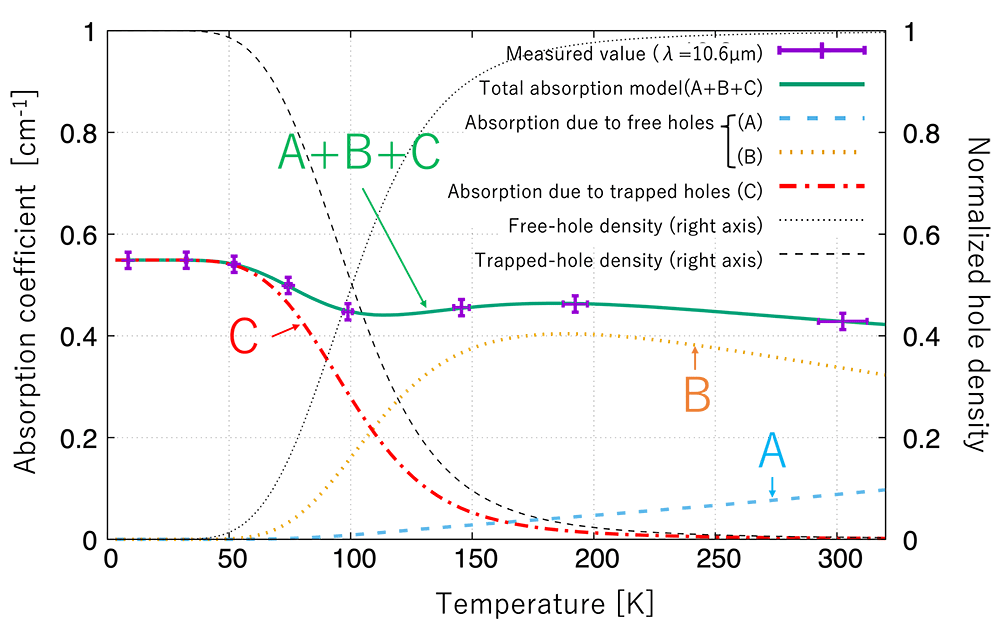Study of optical material for next-generation high-resolution spectroscopic observation: Revealing the cause of infrared absorption in CdZnTe crystals at cryogenic temperature
Jan. 19, 2022 | GATEWAY to Academic Articles
We are developing an optical element called an "Immersion Grating” (IG) to realize high-resolution spectroscopic astronomical observations at wavelengths of 10-20 µm. For the efficiency of the IG, materials with high transmittance are required. CdZnTe (cadmium zinc telluride) is a promising candidate material for the IG at 10-20µm wavelengths. In this study, we measured the absorption rates of CdZnTe crystal substrates in four infrared wavelength bands at cryogenic temperatures (below 10 K), which is the operating temperature of the developing IG. Since the infrared absorption is mainly due to free holes (similar to free positive charges), the absorption rates are expected to be decreased at cryogenic temperatures due to a decrease in free-hole density. However, our result shows that the absorption rate increases at cryogenic temperatures, contrary to the expectation. To reveal the absorption causes, we constructed a model of absorption and discussed whether the measurement results could be explained theoretically. As a result, it was found that while the absorption due to free holes is dominant at room temperature, the absorption due to holes trapped at an impurity level becomes dominant at cryogenic temperatures, and thus absorption rate increases at cryogenic temperatures. This study has enabled us to estimate how much the impurity density needs to be reduced to obtain a suitable material for IG, bringing us closer to the realization of the IG.
Research Summary
The realization of high-resolution spectroscopic observations in 10-20 µm infrared wavelengths is expected to make a great advance in astronomy by enabling the detection of snow lines*1, which have a big impact on planet formation, and the acquisition of organic chemical information on astronomical objects. However, this observation system has not yet been realized due to many issues such as the compactness required for mounting on a satellite to avoid atmospheric absorption, and the operational capability at cryogenic temperatures (below 10 K*2) to reduce infrared noise from the system itself.

To realize this observation, we are developing an optical element called an “Immersion Grating” (IG, Fig. 1). Because a large optical path difference can be obtained by the light propagation through high-refractive-index material, an IG can be more compact than conventional gratings. Due to this compactness, an IG is suitable for optical systems on satellites. An IG requires a material that absorbs very little light (a low absorption coefficient*3) because light needs to pass through the material. CdZnTe (cadmium zinc telluride) is one of the most promising optical materials for developing IG. The IG is planned to be used at cryogenic temperatures to reduce infrared noise from the system itself, but it has been unclear what causes the absorption in cryogenic CdZnTe.

In this study, we measured the absorption coefficient of CdZnTe crystal substrates at cryogenic temperatures to identify the absorption causes at cryogenic temperatures and to investigate the suitability for IG materials. For this study, we made a measurement system of transmittance of cryogenic substrates (Fig 2). Infrared beams in four wavelength bands were irradiated onto CdZnTe crystal substrates at controlled temperatures, and the powers of transmitted light were measured.

Free holes*4 absorb infrared light through excitation (absorption of energy). Since this absorption due to free holes was dominant at room temperature, it was previously expected that the absorption in the 10-20 µm wavelength band would decrease at cryogenic temperatures due to a decrease of the free-hole density. However, our result shows that, contrary to the expectation, the absorption rate increases at cryogenic temperatures. To identify the absorption cause, we constructed a physical model of absorption and investigated whether the measurement results could be explained theoretically. As a result, it is found that absorption due to free holes (A and B in Fig. 3) is dominant at room temperature, while absorption at cryogenic temperatures is dominated by energy being absorbed to holes trapped by impurities in the CdZnTe (transition from an impurity level*5 to the valence band*6) (C in Fig. 3). This causes the absorption rate to increase at cryogenic temperatures.”
In this study, we were able to identify the absorption cause in CdZnTe crystals at cryogenic temperatures using a model. The results also allow us to estimate how much the impurity density in CdZnTe must be controlled to realize a practical cryogenic IG. Our study is expected to advance the development of IGs and realize high wavelength resolution spectroscopic observations in the 10-20µm wavelength range.
Terminologies
- *1 Snowline : The position where water vapor turns to ice in a protoplanetary disk. A protoplanetary disk is a disk around a young star and consists of gas and dust (small solid particles), which are the source of planets. Water exists in a gaseous state inside the snowline and in a solid state outside because area father from the central star has lower temperature. The position of snowline has a major impact on planet formation, as rocky core is formed inside snowline and ice core is formed outside.
- *2 K (Kelvin) : A unit of temperature. If you add 273.15 to the Celsius value, you get the Kelvin value (e.g., 0°C = 273.15 K).
- *3 Absorption coefficient : A physical quantity that indicates the degree of light absorption in a material. For example, if light travels 1 cm through a material with absorption coefficient of 1 cm-1, the light power will be reduced by 1/e (approximately 1/2.7) after transmission.
- *4 Hole : A state with relatively positive charge due to an electron deficiency, which behaves like a “positively charged electron”. Some holes move around freely in a material (free holes) while other holes are trapped to an impurity energy level (trapped holes).
- *5 Impurity level : An energy level created by adding impurities.
- *6 Valence band : An energy band filled with electrons in insulators or semiconductors. The lack of an electron in the valence band becomes a free hole.
- *7 Bandpass filter : A filter transmitting only light in a specific wavelength band.
Information
| Journal Title | Journal of Electronic Materials |
|---|---|
| Full title of the paper | Infrared Absorption and Its Sources of CdZnTe at Cryogenic Temperature |
| DOI | https://doi.org/10.1007/s11664-021-09361-1 |
| Publish date | 03 January 2022 |
| Author(s) | Hiroshi Maeshima, Kosei Matsumoto, Yasuhiro Hirahara, Takao Nakagawa, Ryoichi Koga, Yusuke Hanamura, Takehiko Wada, Koichi Nagase, Shinki Oyabu, Toyoaki Suzuki, Takuma, Kokusho, Hidehiro Kaneda, Daichi Ishikawa |
| ISAS or JAXA member(s) among author(s) | MAESHIMA Hiroshi (Graduate School of Science, The University of Tokyo / Dept. of Space Astronomy and Astrophysics, ISAS), MATSUMOTO Kosei (Graduate School of Science, The University of Tokyo / Dept. of Space Astronomy and Astrophysics, ISAS), NAKAGAWA Takao (Dept. of Space Astronomy and Astrophysics, ISAS), WADA Takehiko (Dept. of Space Astronomy and Astrophysics, ISAS), NAGASE Koichi (ISAS), SUZUKI Toyoaki (Dept. of Space Astronomy and Astrophysics, ISAS) |


 MAESHIMA Hiroshi
MAESHIMA Hiroshi